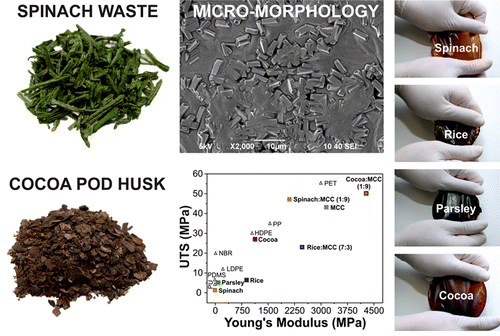Turning waste from rice, parsley and other foods into biodegradable plastic

Your chairs, synthetic rugs and plastic bags could one day be made out of cocoa, rice and vegetable waste rather than petroleum, scientists are now reporting. The novel process they developed and their results, which could help the world deal with its agricultural and plastic waste problems, appear in the ACS journal Macromolecules.
Athanassia Athanassiou, Ilker S. Bayer and colleagues at the Italian Institute of Technology point out that plastic's popularity is constantly growing. In 2012, its production reached 288 million tons worldwide, but its ubiquity comes at a cost. Synthetic plastics persist for hundreds or thousands of years while releasing toxic components with the potential to harm the environment and human health. Also, plastics are made out of petroleum, which is a nonrenewable source. The shift to more environmentally friendly bioplastics has been challenging and expensive. Athanassiou's team wanted to find a simple, less costly way to make the transition.
They turned to an organic acid that also occurs naturally and can process cellulose, which is the main building component of plants and also the most abundant polymer in nature. They mixed the acid with parsley and spinach stems, and husks from rice and cocoa pods. Then, they poured the resulting solutions into lab dishes. When tested, the films that formed showed a promising range of traits from brittle and rigid to soft and stretchable—similar to commercial plastics. "This opens up possibilities for replacing some of the non-degrading polymers with the present bioplastics obtained from agro-waste," the researchers conclude.
More information: Direct Transformation of Edible Vegetable Waste into Bioplastics, Macromolecules, 2014, 47 (15), pp 5135–5143. DOI: 10.1021/ma5008557
Abstract
Bioplastics with a wide range of mechanical properties were directly obtained from industrially processed edible vegetable and cereal wastes. As model systems, we present bioplastics synthesized from wastes of parsley and spinach stems, rice hulls, and cocoa pod husks by digesting in trifluoroacetic acid (TFA), casting, and evaporation. In this way, amorphous cellulose-based plastics are formed. Moreover, many other natural elements present in these plants are carried over into the bioplastics rendering them with many exceptional thermo-physical properties. Here, we show that, due to their broad compatibility with cellulose, amorphous cellulose can be naturally plasticized with these bioplastics by simply mixing during processing. Comparison of their mechanical properties with that of various petroleum based synthetic polymers indicates that these bioplastics have equivalent mechanical properties to the nondegrading ones. This opens up possibilities for replacing some of the nondegrading polymers with the present bioplastics obtained from agro-waste.
Provided by American Chemical Society

















